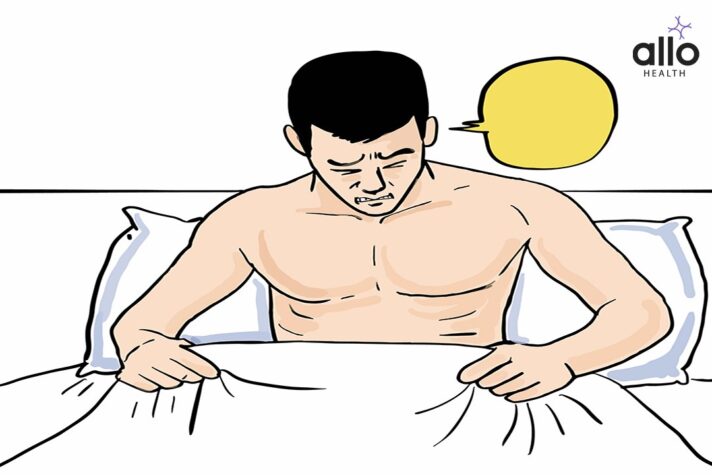The First Ejaculate: A Milestone in Male Development

Allo Health is dedicated to personalized well-being, offering support and trusted information tailored to individual health goals. The platform emphasizes human-generated content, led by a distinguished medical team of experts, including physicians and sexual health specialists. Their commitment to credibility involves rigorous fact-checking, authoritative research, and continuous updates to ensure accurate, up-to-date information. Allo Health's unique approach goes beyond conventional platforms, providing expert-led insights and a continuous commitment to excellence, with user feedback playing a crucial role in shaping the platform's authoritative voice.

Dr Sanina Mansoor holds MBBS degree from Yenepoya university,Mangalore.She has 8 years of experience working as a medical officer at various health centres and medical colleges.
Why This Was Upated?
Our experts continually monitor the health and wellness space, and we update our articles when new information became available.
Updated on 15 June, 2024
- Article was updated as part of our commitment to diversity, equity, and inclusion.

"The following blog article provides general information and insights on various topics. However, it is important to note that the information presented is not intended as professional advice in any specific field or area. The content of this blog is for general educational and informational purposes only.
Book consultation
The content should not be interpreted as endorsement, recommendation, or guarantee of any product, service, or information mentioned. Readers are solely responsible for the decisions and actions they take based on the information provided in this blog. It is essential to exercise individual judgment, critical thinking, and personal responsibility when applying or implementing any information or suggestions discussed in the blog."
In the realm of human growth and progress, certain milestones stand out as pivotal moments in our understanding of development. “A Milestone in Male Development” encapsulates one such breakthrough, illuminating a significant stride in the understanding of male physiology and psychology. Through rigorous research and empirical evidence, this article unveils a comprehensive narrative of advancement in male development, shedding light on intricate facets previously veiled in mystery. From physiological transformations to psychological nuances, this exploration promises to unravel profound insights, enriching our comprehension of male development and paving the way for enhanced well-being and societal progress.
Understanding the Male Reproductive System
The male reproductive system plays a crucial role in sexual development and the process of ejaculation. Here are some key aspects to understand. Anatomy of the Male Reproductive System:
- The male reproductive system comprises various organs and structures responsible for the production and delivery of sperm.
- Testes, located in the scrotum, are the primary organs where sperm production occurs through a process called spermatogenesis.
- Sperm travels from the testes through a network of ducts, including the epididymis, vas deferens, ejaculatory ducts, and urethra, during ejaculation.
- The accessory glands, such as the seminal vesicles, prostate gland, and bulbourethral glands, produce seminal fluid, which nourishes and transports sperm.
- Hormones, including testosterone, play a crucial role in regulating the male reproductive system, influencing sperm production, libido, and secondary sexual characteristics.
- Proper functioning of the male reproductive system is essential for fertility and sexual health.
- Understanding the male reproductive system aids in addressing issues like infertility, erectile dysfunction, and sexually transmitted infections.
The Science Behind Ejaculation
Understanding the scientific process behind ejaculation can help you prepare for this significant event and may help you from suffering sexual dysfunction.
Arousal and Erection:
- Sexual stimulation or sexual excitement through emotional intimacy, and physical or mental stimulation leads to sexual arousal.
- The brain releases neurotransmitters that cause increased blood flow to the penis, resulting in an erection.
The Ejaculation Process:
- Emission phase: During sexual climax during sexual intercourse, the muscles in the vas deferens, seminal vesicles, and prostate contract, pushing semen into the urethra.
- Expulsion phase: Muscles around the base of the penis contract rhythmically, propelling semen out of the body in a series of spurts, this is produced under the influence of the male hormone testosterone, as without this testosterone the glands cannot secrete fluids.
Emotional and Physical Well-being:
- It is essential to be in a comfortable and safe environment for your first ejaculation.
- Emotional preparedness, understanding consent, and communication with your partner are crucial aspects of a healthy sexual experience.
Ejaculation or conscious ejaculation typically begins when an individual enters puberty and starts producing sperm. The onset of puberty varies among individuals, with most experiencing it between the ages of 10 and 12. Within this age range, it is common for individuals to have their first typical ejaculation. This often occurs during a “wet dream aka nocturnal emission” or through masturbation. However, the exact timing can differ, and it is reasonable to expect the first ejaculation to happen within a few months to a year after the onset of puberty.
What to Expect During Your First Ejaculation?

Experiencing the first-ever ejaculation is a natural and normal part of male sexual development. It’s an event that may bring curiosity, excitement, and a range of emotions.
Physical Sensations:
- The buildup of Pleasure: As you engage in sexual activity, whether through masturbation or with a partner, you will likely experience a gradual buildup of pleasurable sensations in your genital area.
- Heightened Sensitivity: As you near ejaculation, you may notice increased sensitivity in your penis. This can manifest as a heightened feeling of arousal and a more intense pleasure.
- Contractions: During ejaculation, rhythmic contractions occur in the pelvic region, specifically the muscles surrounding the vas deferens, seminal vesicles, and prostate gland. These contractions propel semen through the urethra and out of the body.
- Release of Semen: Your first ejaculation will involve the release of semen, a mixture of sperm cells and fluids from the seminal vesicles and prostate gland. The semen is expelled from the penis in a series of spurts.
Emotional Response:
- Excitement: Your first ejaculation can evoke feelings of excitement and accomplishment as you experience a new aspect of your sexual development.
- Curiosity and Wonder: It’s natural to be curious and intrigued about the changes happening in your body. Embrace this curiosity and view it as an opportunity for self-discovery.
- Possible Anxiety: Some individuals may experience anxiety or nervousness leading up to their first ejaculation. This is normal, and it can help to remind yourself that it’s a natural process and a part of growing up.
- Emotional Connection: If you are engaging in sexual activity with a partner, your first ejaculation may create a deeper emotional connection and intimacy between you both. Open and honest communication can enhance this experience.
Clean-Up and Hygiene:
- All Clean: Ejaculation typically results in the release of semen, which will require cleaning up afterward. Keep tissues or wipes nearby to ensure hygiene and comfort.
- Hygiene: It’s important to maintain good hygiene by washing your hands and genital area after ejaculation to prevent any potential infections.
Recognizing the Signs of Impending Ejaculation

Understanding the signs and signals that indicate impending ejaculation is an important aspect of sexual awareness and control. Being able to recognize these signs can help you better manage and prolong sexual activity.
Physical Signs:
- Increased Sexual Arousal: As you engage in sexual activity, you may notice a gradual increase in sexual arousal. This can manifest as a heightened sensation in the genital area, including the penis becoming erect and more sensitive to touch.
- Swelling and Tension: Just before ejaculation, you may experience a sense of swelling and tension in the pelvic region. This can include increased blood flow to the penis, resulting in a fuller and harder erection.
- Muscle Contractions: As ejaculation draws near, you may feel involuntary contractions in the pelvic floor muscles, including the muscles surrounding the vas deferens and prostate gland.
Psychological Signs:
- Heightened Pleasure: As ejaculation approaches, you may experience a significant increase in pleasure and sexual intensity. This can be accompanied by a sense of building excitement and a more urgent desire to reach orgasm.
- Altered Breathing and Heart Rate: As sexual excitement escalates, you may notice changes in your breathing pattern, such as faster and deeper breaths. Your heart rate may also increase as a response to heightened arousal.
- Loss of Control: A sense of losing control over your ability to delay ejaculation is another psychological sign that orgasm is approaching. This can be accompanied by a feeling of inevitability or an intense desire to release.
Communication and Practice:
- Open Communication: It’s essential to establish open and honest communication. By discussing your sexual preferences, boundaries, and desires, you can work together to enhance your sexual experience and understand each other’s needs.
- Practice Techniques: Learning techniques such as the “stop-start” or “squeeze” method can help you gain better control over ejaculation. These techniques involve pausing or applying pressure to the base of the penis to delay orgasm and prolong sexual activity.
Tips for Achieving Stronger and More Intense Ejaculations

- Hydration is key: Drink plenty of water to maintain healthy semen production.
- A balanced diet: Incorporate foods rich in zinc, such as oysters, and vitamins C and E for optimal reproductive health.
- Regular exercise: Enhance blood flow to the genital area through cardio and pelvic floor exercises.
- Kegel exercises: Strengthen pelvic floor muscles for more powerful contractions during ejaculation.
- Limit alcohol and tobacco: Both can negatively impact sperm quality and ejaculation intensity.
- Manage stress: High-stress levels can affect sexual performance, so practice relaxation techniques.
- Communication: Discuss preferences and techniques with your partner for mutual satisfaction.
Factors that Affect Ejaculation Frequency
- Age: Ejaculation frequency often decreases with age due to hormonal changes and physiological factors.
- Sexual activity: Increased sexual activity typically correlates with higher ejaculation frequency.
- Health conditions: Certain medical conditions like prostate issues or erectile dysfunction can impact ejaculation frequency.
- Medications: Some medications, such as antidepressants or anti-anxiety drugs, may affect ejaculation frequency as a side effect.
- Stress levels: High levels of stress can lead to decreased libido and potentially lower ejaculation frequency.
- Lifestyle factors: Diet, exercise, and overall lifestyle choices can influence sexual function and ejaculation frequency.
Safety Considerations for First-Time Ejaculators
For individuals experiencing ejaculation for the first time, prioritizing safety is paramount. Understanding bodily responses and potential risks is crucial. Proper hygiene practices, such as washing hands and genitalia before and after, reduce the risk of infection. Employing contraception helps prevent unintended pregnancy and sexually transmitted infections. Communicating openly with a trusted partner about boundaries and consent fosters a respectful and safe environment. Seeking information from reliable sources and consulting healthcare professionals can offer personalized guidance. By prioritizing safety measures and informed decision-making, first-time ejaculators can enjoy a fulfilling and risk-aware experience.
Conclusions
In conclusion, the onset of the first ejaculate represents a significant milestone in male development, marking the maturation of reproductive capabilities. This seminal event not only signifies physiological changes but also carries profound psychological implications as adolescents navigate their emerging sexuality. Understanding this milestone is crucial for adolescents, parents, and healthcare providers alike, as it underscores the importance of open communication and comprehensive education surrounding sexual health. Embracing this developmental milestone fosters informed decision-making and promotes overall well-being in young men.
Most Asked Questions
-
What is ejaculation?
Ejaculation is the process by which semen, a mixture of sperm cells and fluids, is released from the penis. It is a natural and involuntary response that occurs during sexual climax.
-
Is ejaculation the same as orgasm?
Ejaculation and orgasm are closely related but distinct experiences. Ejaculation refers to the physical release of semen, while orgasm is the pleasurable and intense sensation that accompanies it. While ejaculation and orgasm often occur together, it is possible to have an orgasm without ejaculation and vice versa.
-
Can you control or delay ejaculation?
Yes, it is possible to develop control over ejaculation through practice and various techniques. Techniques such as the "stop-start" and "squeeze" methods can help delay ejaculation and prolong sexual activity. Additionally, open communication with your partner, relaxation techniques, and exploring different levels of arousal can contribute to better control.
-
Is it normal to ejaculate quickly?
Quick or premature ejaculation, where ejaculation happens sooner than desired, is relatively common among males, especially in younger individuals. However, if it becomes a persistent concern and affects your sexual satisfaction or relationships, it may be beneficial to seek guidance from a healthcare professional or a sex therapist.
-
Can you ejaculate without an erection?
Typically, ejaculation occurs alongside an erection, as increased blood flow to the penis is necessary for both processes. However, it is possible to have a partial erection or even ejaculate with a flaccid or semi-erect penis, although this is less common. The presence or absence of an erection can vary depending on individual circumstances and factors involved.






































